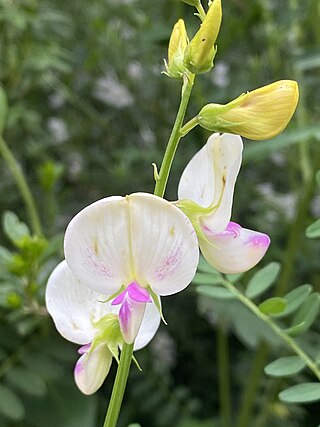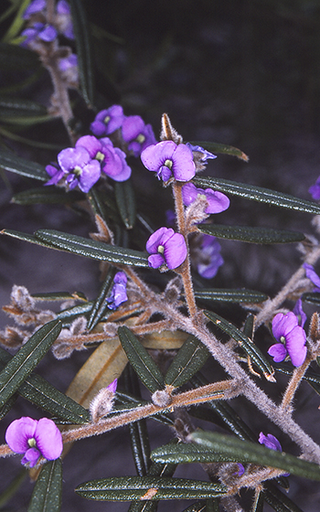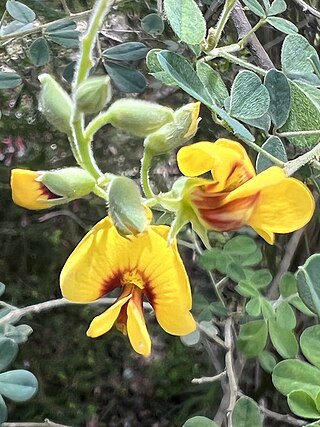
Hovea pannosa is a species of flowering shrub in the family Fabaceae and is endemic to Australia. It is a small, erect shrub with purple pea flowers and stiff green leaves.

Podolobium, commonly known as shaggy peas, is a genus of six species of flowering plants in the family Fabaceae that are endemic to eastern Australia. The genus was formally described by botanist Robert Brown in Hortus Kewensis in 1811.

Podolobium alpestre, commonly known as alpine shaggy-pea, is a flowering plant in the family Fabaceae and is endemic to south-eastern Australia. It has oblong to egg-shaped leaves and yellow to orange pea-like flowers with red markings.

Hovea lanceolata is a flowering plant in the family Fabaceae. It is a small shrub with elliptic leaves and purple pea flowers. It grows in New South Wales and Queensland.

Olearia erubescens, commonly known as moth daisy-bush or pink-tip daisy-bush, is a species of flowering plant in the family Asteraceae. It is a shrub with stiff, prickly leaves and white "daisy" flowers, growing up to 2 metres high.

Pultenaea juniperina, commonly known as prickly bush-pea or prickly beauty is a species of flowering plant in the family Fabaceae and is endemic to south-eastern Australia. It is an erect, spiky shrub with hairy stems, linear to narrow elliptic leaves with stipules at the base, and yellow-orange and red flowers.

Oxylobium ellipticum, commonly known as the common shaggy-pea, is a flowering plant in the family Fabaceae. It has dense clusters of yellow pea flowers and elliptic-shaped leaves. It grows in south-eastern Australia.

Oxylobium arborescens, commonly known as the tall shaggy-pea, is a species of flowering shrub to small tree in the family Fabaceae and is endemic to south-eastern Australia. It has elliptic dark green leaves and yellow pea flowers.

Podolobium procumbens, commonly known as trailing shaggy-pea, trailing podolobium or trailing oxylobium, is a flowering plant in the family Fabaceae and is endemic to south-eastern Australia. It is a trailing small shrub with oval-shaped leaves and orange pea-like flowers.

Ozothamnus alpinus, commonly known as alpine everlasting, is a flowering plant in the family Asteraceae. It is endemic to alpine and subalpine areas in south-eastern continental Australia.

Podolobium aciculiferum, commonly known as needle shaggy-pea, is a flowering plant in the family Fabaceae and endemic to eastern Australia. It has stiff, pointed leaves and yellow pea-like flowers with red markings.

Eucalyptus consideniana, commonly known as yertchuk, is a species of plant in the myrtle family and is endemic to south-eastern Australia. It is a tree with rough, fibrous, sometimes prickly bark on the trunk and larger branches, smooth grey bark above, lance-shaped or curved adult leaves, flower buds in groups of between eleven and nineteen, white flowers and conical to hemispherical fruit.

Acacia colletioides, commonly known as wait-a-while, pin bush and spine bush, is a shrub of the genus Acacia and the subgenus Plurinerves that is native to Australia.

Oxylobium cordifolium, commonly known as the heart-leaved shaggy pea, is a species of flowering plant in the family Fabaceae and is endemic to New South Wales. It is a small, prostrate shrub with long, wiry branches, heart-shaped leaves and orange-red flowers.

Swainsona sejuncta is a species of flowering plant in the family Fabaceae. It has pea-shaped flowers in a variety of colours, pink, cream, orange and mauve from spring to summer and is endemic to Queensland.

Hovea purpurea, commonly known as velvet hovea, is a flowering plant in the family Fabaceae. It is an upright shrub with narrow leaves, purple pea flowers and stems with matted hairs. It grows in New South Wales, Victoria and South Australia.

Podolobium aestivum, is a flowering plant in the family Fabaceae and is endemic to New South Wales, Australia. It is an upright shrub with green spiky leaves and orange pea-like flowers.

Podolobium scandens, commonly known as netted shaggy-pea, is a flowering plant in the family Fabaceae and is endemic to eastern Australia. It is a prostrate, small shrub with orange-yellow pea-like flowers and red markings.
Pultenaea trichophylla, commonly known as tufted bush-pea, is a species of flowering plant in the family Fabaceae and is endemic to South Australia. It is a slender, prostrate to erect shrub with hairy branchlets, lance-shaped leaves, and yellow to orange and red, pea-like flowers.

Goodia pubescens, commonly known as golden tip, is a flowering plant in the family Fabaceae. It has yellow pea flowers, bluish-green leaves and found in Victoria and New South Wales.



















